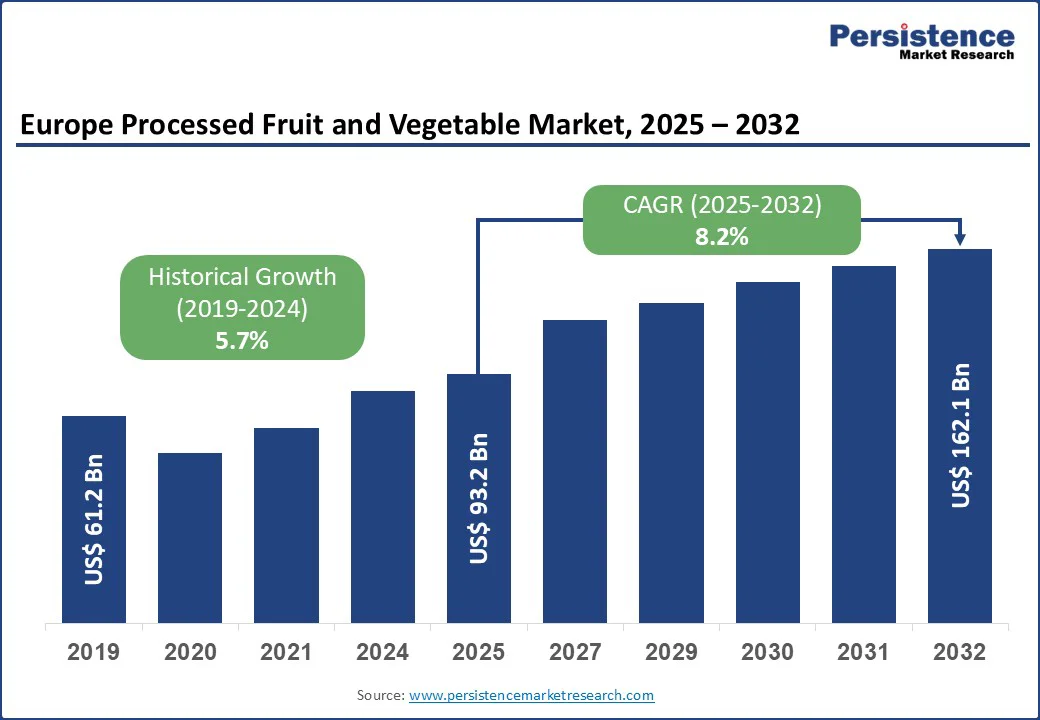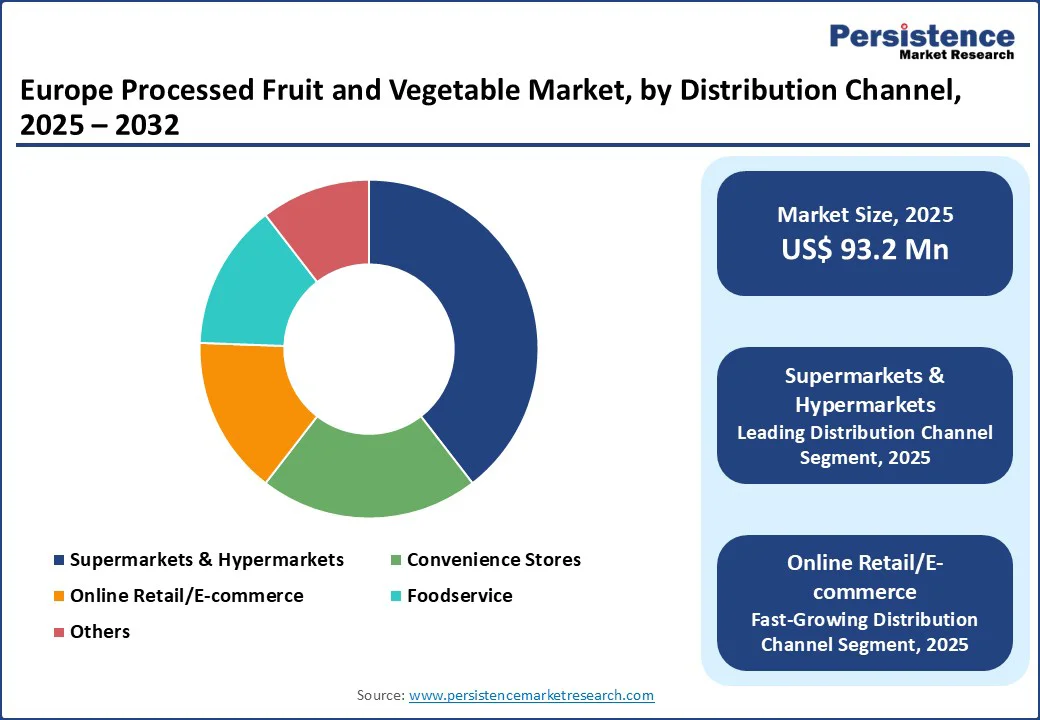ID: PMRREP35756| 192 Pages | 19 Oct 2025 | Format: PDF, Excel, PPT* | Food and Beverages

Europe processed fruit and vegetable market size is likely to be valued at US$ 93.2 Billion in 2025 and is expected to reach US$ 162.1 Billion by 2032 growing at a CAGR of 8.2% during the forecast period from 2025 to 2032, driven by changing consumer lifestyles favoring convenient and healthy food options along with advances in food processing technologies that enhance product shelf life and quality.
| Key Insights | Details |
|---|---|
| Europe Processed Fruit and Vegetable Market Size (2025E) | US$93.2 Bn |
| Market Value Forecast (2032F) | US$162.1 Bn |
| Projected Growth (CAGR 2025 to 2032) | 8.2% |
| Historical Market Growth (CAGR 2019 to 2024) | 5.7% |

Advanced preservation technologies such as High-Pressure Processing (HPP), Individually Quick Frozen (IQF), and aseptic processing are revolutionizing Europe’s processed fruit and vegetable market. HPP enables producers to extend shelf life while retaining the natural taste, color, and nutritional value of fruits and vegetables, as it avoids heat-based degradation. IQF allows individual pieces to be frozen rapidly, preserving texture and freshness, making it ideal for ready-to-use ingredients in both retail and foodservice.
Aseptic processing sterilizes the product and packaging separately, ensuring safety without chemical preservatives. These technologies not only unlock new product categories such as premium cold-pressed juices, fresh-tasting purees, and clean-label snacks but also enhance food safety, reduce waste, and cater to the growing consumer demand for minimally processed, high-quality, and convenient options.
The European Union is moving decisively toward sustainable packaging, and one of the most significant changes affecting the processed fruit and vegetable sector is the upcoming ban on single-use plastic packaging for pre-packed fruits and vegetables under 1.5 kg, set to take effect from January 1, 2030. This regulation aims to reduce plastic waste, encourage eco-friendly alternatives, and aligns with broader EU environmental targets.
For producers and processors, this change presents both a challenge and an opportunity. They will need to invest in innovative packaging solutions such as biodegradable films, recyclable materials, or compostable containers, redesign supply chains, and educate consumers about the new packaging formats. Failure to adapt could result in regulatory penalties and loss of market share.
Sustainable packaging solutions are rapidly becoming a defining factor in Europe processed fruit and vegetable market. Consumers are no longer satisfied with merely high-quality produce; they increasingly demand eco-friendly packaging that minimizes environmental impact. Biodegradable materials, compostable films, and reduced-plastic alternatives are gaining traction, aligning with the broader global push toward a circular economy.
Beyond meeting stringent EU regulatory requirements on packaging waste and recyclability, sustainable packaging enhances brand perception, creating a strong emotional connection with environmentally conscious buyers. Innovative approaches, such as edible coatings, plant-based wraps, and reusable containers, not only preserve product freshness but also reduce carbon footprints. Companies investing in these solutions gain a competitive edge while actively contributing to environmental sustainability.
The processed fruits segment leads the market due to a combination of convenience, versatility, and health-driven consumer trends. Europeans increasingly seek ready-to-eat, nutritious, and flavorful options that fit busy lifestyles, making products such as canned fruits, fruit purees, and dried snacks highly attractive.
Fruits are also easier to incorporate into beverages, desserts, and functional foods, enhancing their versatility across multiple applications. Rising awareness of antioxidant-rich diets, immune-boosting benefits, and natural sugar alternatives further fuels demand. Additionally, strong branding, innovative packaging, and seasonal variety promotions reinforce consumer preference, ensuring processed fruits consistently outpace processed vegetables in market share and growth.
Supermarkets and hypermarkets command approximately 60% market share due to their extensive networks and ability to offer broad product assortments. These channels benefit from promotional activities and prime shelf positioning for processed fruit and vegetable products.
Germany and the Netherlands serve as major import hubs, with their robust retail infrastructure facilitating distribution across Europe. The rise of e-commerce has introduced new growth pathways, while convenience stores and foodservice outlets cater to impulse purchases and bulk buying behaviors, respectively.

Italy leads Europe processed fruit and vegetable market due to its strong agricultural heritage, favorable climate, and well-established supply chain infrastructure. The country produces a diverse range of high-quality fruits and vegetables, including tomatoes, berries, and citrus, which are ideal for processing. Italian companies have invested heavily in advanced processing technologies, cold storage, and packaging solutions, ensuring consistent quality and longer shelf life.
Additionally, Italy benefits from a robust export network and strong domestic consumption driven by its culinary culture and demand for convenient, ready-to-use ingredients. Government support, adherence to strict EU food safety standards, and innovation in value-added products further strengthen Italy’s position as the leading hub for processed fruits and vegetables in Europe.
Europe processed fruit and vegetable market exhibits a highly competitive landscape shaped by both multinational giants and specialized regional players. Key companies focus on product innovation, sustainable sourcing, and advanced processing technologies to differentiate themselves.
Strategic mergers, acquisitions, and partnerships are common to expand geographic reach and strengthen supply chains. Branding, organic certifications, and clean-label offerings are leveraged to capture health-conscious consumers.
Europe processed fruit and vegetable market is projected to be valued at US$93.2 Bn in 2025.
Key drivers include urbanization, changing lifestyles favoring convenience, technological advancements in processing, and growing health consciousness among consumers.
Europe processed fruit and vegetable market is poised to witness a CAGR of 8.2% between 2025 and 2032.
Major opportunities include organic and functional product segments, sustainability initiatives, and circular economy models encouraged by EU regulations.
Germany accounts for a major share in Europe processed fruit and vegetable market.
| Report Attribute | Details |
|---|---|
| Historical Data/Actuals | 2019 - 2024 |
| Forecast Period | 2025 - 2032 |
| Market Analysis | Value: US$ Bn |
| Geographical Coverage |
|
| Segmental Coverage |
|
| Competitive Analysis |
|
| Report Highlights |
|
By Product Type
By Distribution Channel
By End-user
By Country
Delivery Timelines
For more information on this report and its delivery timelines please get in touch with our sales team.
About Author